Last updated on January 15, 2024

Woe Strider | Illustration by John Thacker
If you’ve been playing Magic for a while then you may have come across the slang term “aristocrats.” You might know what it means, but given that the term is nearly ten years old at this point then there’s a very good chance that the meaning might have been lost. Or at least the origin of it.
Today, we’re going to talk about aristocrats in Magic. What are they, where does the term come from, and how do you use them optimally?
Let's find out!
What are Aristocrats in Magic?

Falkenrath Aristocrat | Illustration by Igor Kieryluk
Let’s head back in time to early 2013 and Pro Tour Gatecrash. Team SCG took the event by storm with a deck that they coined as “The Aristocrats.” This was a Mardu () deck based on controlling the board using creatures. It included some human type synergies and most notably some sacrifice synergies. The name came from the two sacrifice outlets that the deck played: Cartel Aristocrat and Falkenrath Aristocrat. The deck’s creator, legendary deck designer Sam Black, described the ability to sacrifice a creature as one of the most powerful things you can do in Magic.
The team did very well with Aristocrats and Tom Martell even won the whole event with it. Since then it became a force to be reckoned with until it rotated. Nowadays, the term “aristocrat” is colloquially used to describe any creature that allows you to sacrifice creatures for value. Here is Tom Martell’s winning decklist:
Creature (30)
Doomed Traveler x4
Champion of the Parish x4
Cartel Aristocrat x4
Skirsdag High Priest x2
Knight of Infamy x3
Silverblade Paladin x2
Boros Reckoner x4
Falkenrath Aristocrat x4
Restoration Angel
Zealous Conscripts x2
Instant (4)
Orzhov Charm x4
Sorcery (2)
Land (24)
Godless Shrine x4
Blood Crypt x4
Sacred Foundry x4
Isolated Chapel x4
Plains x3
Cavern of Souls x3
Clifftop Retreat
Vault of the Archangel
Sideboard (15)
Tragic Slip x3
Rest in Peace x2
Skirsdag High Priest
Lingering Souls x2
Mentor of the Meek
Sorin, Lord of Innistrad x2
Obzedat, Ghost Council x2
Blasphemous Act x2
Honorable Mentions
Ever since that fateful event in 2013, aristocrats have been a big part of the Magic landscape. Many Draft sets nowadays have used aristocrats to create a Rakdos () sacrifices Draft archetype. Food sacrifice decks were a mainstay of Standard a few years ago and are even still a big part of the Historic metagame. But with all of the different versions printed over the years, which ones stand out as the best ever? Here’s a few that have stood out to me.
I’ll kick this off with a couple of honorable mentions. These cards aren’t technically “aristocrats” since they’re not creatures, but they’re still very powerful sacrifice outlets nonetheless.
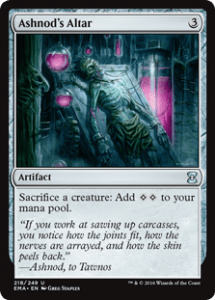
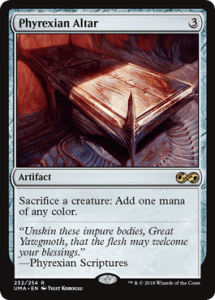
If you’re a Commander player, you will no doubt be familiar with Ashnod's Altar and Phyrexian Altar. Not only do they act as sacrifice outlets to give you a very relevant amount of mana, but they’re part of some nasty infinite combos too.
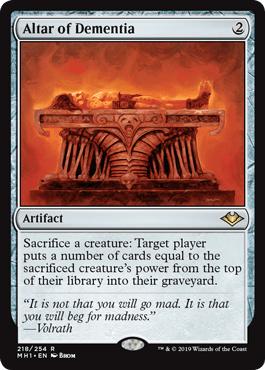
Sticking with the altar theme, we can’t forget Altar of Dementia, a key combo piece from the format-dominating Hogaak, Arisen Necropolis decks in Modern.
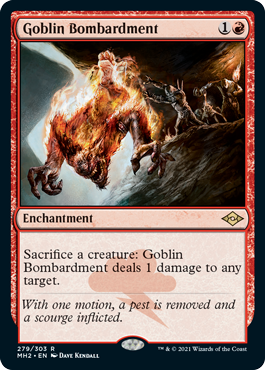
And one of the original engines for all of these kinds of decks was Goblin Bombardment, a card that Sam Black has made work in Legacy on multiple occasions.
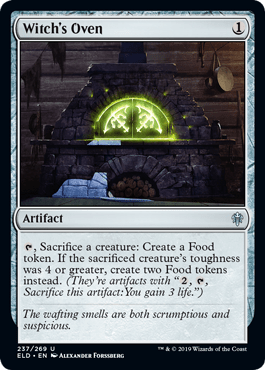
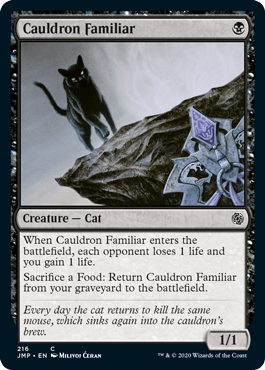
Finally, who can forget Witch's Oven and Cauldron Familiar? This combo is the biggest reason that the Standard and Historic Food decks exist. Looping these two cards each turn and triggering each of your payoffs is what makes the deck tick. This combo was prevalent enough that it got banned in Standard before we had to face an additional year of it dominating the format.
#9. Ghave, Guru of Spores
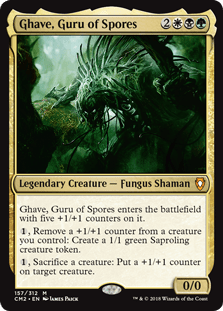
Ghave, Guru of Spores was one of the commanders from the original set of Commander precons back in 2011. It’s a commander that combines an aristocrat with both a token and counter generator. Saproling tokens are an archetype in their own right but they’re very handy to sacrifice and so go very well with these kinds of decks too.
#8. Extus, Oriq Overlord / Awaken the Blood Avatar
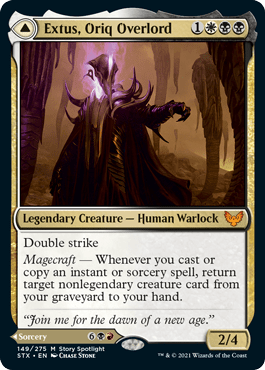
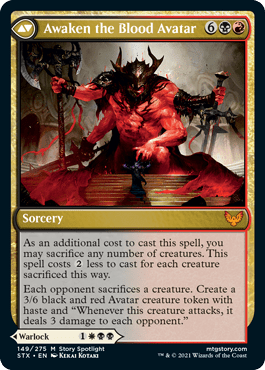
While not strictly an aristocrat I wanted to highlight Extus, Oriq Overlord as my choice for an aristocrat commander. It’s not only a sacrifice outlet built into your commander, it’s also a repeatable one that comes from the command zone.
The plan is to always cast this as Awaken the Blood Avatar. Each time you do it goes straight back to the command zone to be recast later. You can sacrifice a bunch of your creatures to satisfy the cost each time you cast it, triggering all of your payoffs.
#7. Brion Stoutarm
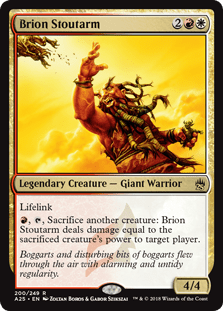
We’re now going to swing over to the world of Commander. Aristocrats have long been a popular choice for EDH decks and there are some very powerful options available if you go down that route.
Brion Stoutarm has long been a popular choice as one of the few Boros () legendary creatures that doesn’t focus on attacking. It’s an aristocrat that lets you Fling creatures at your opponents each turn. If you’re looking for a different kind of Boros deck then look no further than Brion Stoutarm.
#6. Yawgmoth, Thran Physician

While not quite as powerful as the Urza printed in the same set, this first printing of a classic Magic character is still one of the most powerful aristocrats we’ve ever seen. Although Yawgmoth, Thran Physician took some time to get played in Modern, a Golgari () Yawgmoth deck eventually surfaced and ended up as a mainstay deck of the format.
Here’s a version that MTGO player GontiLordOfStuff won a recent Modern Challenge with:
Creature (27)
Birds of Paradise x4
Ignoble Hierarch x4
Young Wolf x4
Blood Artist
Strangleroot Geist x4
Wall of Roots x4
Endurance
Geralf's Messenger
Yawgmoth, Thran Physician x4
Planeswalker (4)
Instant (4)
Sorcery (4)
Thoughtseize
Eldritch Evolution x3
Land (21)
Blooming Marsh x3
Boseiju, Who Endures x2
Dryad Arbor
Forest x2
Misty Rainforest x2
Nurturing Peatland x2
Overgrown Tomb x2
Swamp
Twilight Mire
Urborg, Tomb of Yawgmoth
Verdant Catacombs x4
Sideboard (15)
Fatal Push
Thoughtseize x2
Veil of Summer
Collector Ouphe
Outland Liberator
Scavenging Ooze
Endurance
Necromentia x2
Force of Vigor x2
Obstinate Baloth
Crime // Punishment x2
This deck combines Yawgmoth, Grist, the Hunger Tide, and Eldritch Evolution with undying creatures to gain card advantage and board presence. This is probably the most current aristocrats deck for competitive play.
#5. Woe Strider
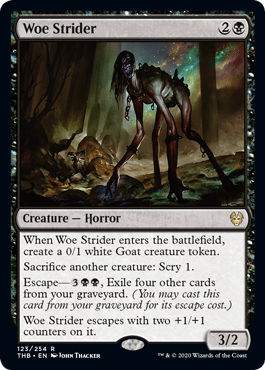
Circling back to the recent Food decks in Standard and Historic, one of the key pieces in many of them was Woe Strider. This card gives you both a sacrifice outlet and a throwaway token to sacrifice to it.
The escape cost on it also gives you an inevitable late game threat that just lets you keep bringing back a sacrifice outlet over and over again. Alongside the Cat/Oven combo I already mentioned and other aristocrat benefits like Priest of Forgotten Gods and Midnight Reaper, this card helped create a deck that won event after event.
#4. Nantuko Husk

Nantuko Husk looks like a very simple card, and it is. There have been a number of identical cards identical printed in various sets over the years, but it was Husk in particular that made waves in competitive Standard. Rally the Ancestors was a card that had a whole format-defining deck built around it.
Here’s a sample decklist from GP Houston in 2016, piloted to a Top 8 finish by Brock Parker:
Creature (28)
Sidisi's Faithful x2
Jace, Vryn's Prodigy x4
Zulaport Cutthroat x4
Elvish Visionary x4
Ayli, Eternal Pilgrim
Nantuko Husk x4
Catacomb Sifter x4
Grim Haruspex
Reflector Mage x4
Instant (8)
Collected Company x4
Rally the Ancestors x4
Land (24)
Plains
Island
Swamp
Forest
Prairie Stream
Canopy Vista x2
Sunken Hollow x2
Flooded Strand x4
Windswept Heath x4
Polluted Delta x4
Evolving Wilds x3
Sideboard (15)
Despise x2
Dispel x4
Duress
Arashin Cleric x4
Disdainful Stroke
Minister of Pain
Murderous Cut x2
This deck had a simple plan. Play Nantuko Husk, cast Rally the Ancestors for X=3, reanimate all of the creatures from your graveyard, and sacrifice them all to the Husk, triggering Catacomb Sifter, Grim Haruspex, and Zulaport Cutthroat each time. You then get to attack with your big Husk for a lot more damage. Since you sacrificed all of your reanimated creatures they don’t get exiled at the end of the turn by Rally’s drawback, so they’re all still in the graveyard and waiting for you to reanimate them again.
You can even play a “value Rally” with no Nantuko Husk on board, just sacrificing it after sacrificing everything else to just allow you to draw a load of cards and get a bunch of life drains.
The deck was a powerhouse in Standard for quite some time. A lot of the deck’s shell still survived in the Bant () Company decks that came after it even after Rally the Ancestors rotated, including the one that Brian Braun-Duin used to win the World Championships in 2016.
#3. Viscera Seer
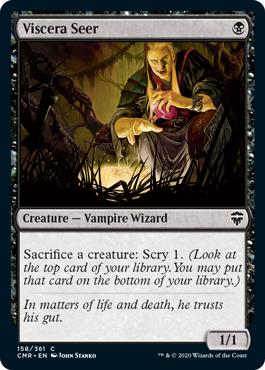
The other 1-drop aristocrat we have access to is Viscera Seer. Seer was the go-to for any deck that needed a cheap aristocrat until Carrion Feeder was printed in Modern Horizons. Its main use was in the Birthing Pod decks of a few years ago where it was part of a 3-card combo with Kitchen Finks and Melira, Sylvok Outcast.
The combo needed a sacrifice outlet to gain its infinite life but Viscera Seer meant that this also gave you an infinite number of scry 1 activations. This let the deck set up for finding the Murderous Redcap that then turned the combo into infinite damage on the following turn.
#2. Carrion Feeder

Easily one of the best sacrifice outlets out there, the 1-mana Carrion Feeder is the cheapest aristocrat in the game, and one that represents a very real threat once enough creatures have been sacrificed. A lot of aristocrat decks are pretty aggressive which makes this card the perfect 1-drop to set the deck’s plan in motion.
#1. Cartel Aristocrat | Falkenrath Aristocrat
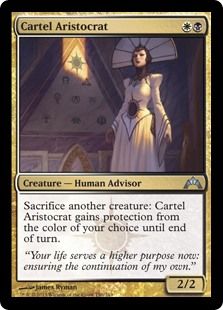

The original aristocrats. The aristocrats deck became a Standard mainstay for at least the next year following Cartel Aristocrat and Falkenrath Aristocrat, eventually evolving into a Mardu midrange deck with a sacrifice subtheme.
Falkenrath was an all-star that dominated in a number of decks. Not only is it a sacrifice outlet, it’s also just a 4-power flying haste creature that was a big hit for aggro decks of the time.
Best Aristocrat Payoffs
The reason it’s so good to sacrifice creatures so freely is because we are afforded with many payoffs for doing so. Not only do we have an abundance of throwaway creatures so that we can take advantage of the abilities that our aristocrats give us, but we can also throw in permanents that pay us off whenever we sacrifice something. All of these aristocrat decks have contained something to do this for us and so here are some of the best ones available for your next deck.
Mayhem Devil
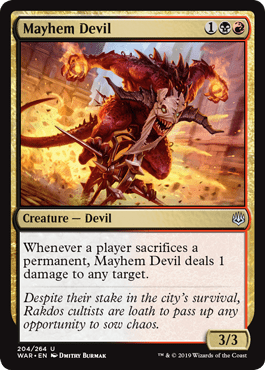
Perhaps the biggest reason that the Standard and Historic Food decks were so powerful, Mayhem Devil is one of the most powerful payoffs we have ever seen for this strategy. One damage to any target might not sound like a lot, but given that you can sacrifice permanents several times in the same turn, Mayhem Devil ends up being able to kill off most creatures and eventually your opponent. And for killing opponents we have an even better option.
Blood Artist
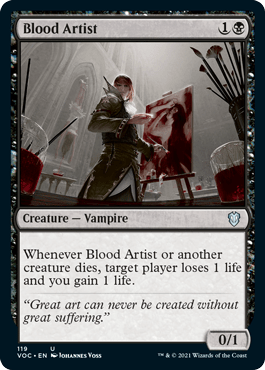
One of the best options and one that saw play in many of the original aristocrat decks is Blood Artist. While hitting your opponent for damage is a good win condition, what’s actually more relevant here is the life gain that these kinds of creatures give you. Your clock isn’t very fast with these kinds of decks and so you need to be able to stay alive for as long as possible to allow you enough turns to assemble your various components. There are some other options available too, including Zulaport Cutthroat, Bastion of Remembrance, Cruel Celebrant, and Falkenrath Noble.
Pitiless Plunderer
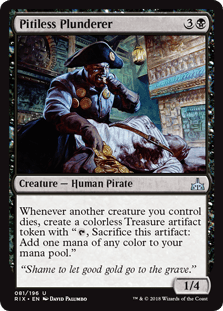
It’s not every day you come across a $10 uncommon that was printed in the last few years, but here we are. Pitiless Plunderer pays you off with a Treasure token, a fairly unique reward in that not only is it a desirable pay off but also another thing for you to sacrifice. More mana and more permanents to sacrifice are two things that these kinds of decks are always happy to see. Pawn of Ulamog is also a powerful option that gives a very similar benefit.
Midnight Reaper
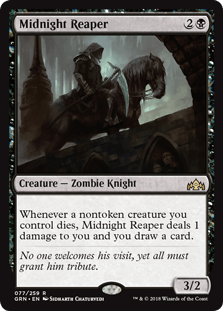
Drawing a card every time you perform an action is one of the most important payoffs you can get in a game of Magic. Midnight Reaper is one of the simplest versions of this and it’s very important to have a few of these around. Other options include Grim Haruspex, Liliana, Dreadhorde General, and Moldervine Reclamation.
Grave Pact
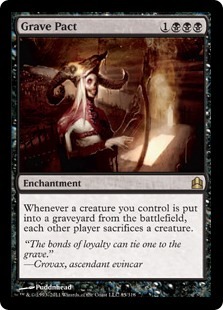
You may be happy to sacrifice your permanents but I doubt your opponents will be quite so happy to sacrifice theirs. Grave Pact is a devastating permanent that could easily wipe the board of your opponents’ creatures in short order. We also have Dictate of Erebos and Martyr's Bond as additional options that help you run rampant on your opponents’ board states. Martyr's Bond even lets you attack other kinds of permanents by sacrificing other things such as Treasure and Food tokens.
How Do You Play Aristocrats Decks?
Aristocrat decks are typically quite aggressive. You generally want to be curving out permanents in the early turns until you get to a point where sacrificing creatures gives you enough of a benefit to start doing it each turn. You typically require three things for an ideal board state:
- An aristocrat
- Sacrifice fodder
- A payoff
For example, if you take the 2013 Pro-Tour-winning deck from earlier in the article, you can play Doomed Traveler (sacrifice fodder) on turn 1, Skirsdag High Priest (a payoff) on turn 2, and then on turn 3 when you play a Cartel Aristocrat you can sacrifice your Traveler in order to create a Demon token.
Once you’ve developed a board state, the key is to find ways to win. Usually, this is done with some of the payoffs I talked about earlier, but this can take quite some time, so you end up needing to stall for time. One of the reasons that Cauldron Familiar and Witch's Oven is such a powerful combo is that while you can repeat it every turn you can also use the cat to block an attacker and soak up a bunch of damage.
Another benefit is often that the threats an aristocrats deck deploys are very hard to remove. If there are a few creatures on your board, your opponent is not going to be able to kill a Nantuko Husk with any damage-based removal. Pointing removal at your creatures with an aristocrat on board is also not going to work as they can be sacrificed in response and all of your payoffs will still trigger. This combination makes sacrifice decks one of the most annoying strategies to play against.
How Do Aristocrats Decks Win?
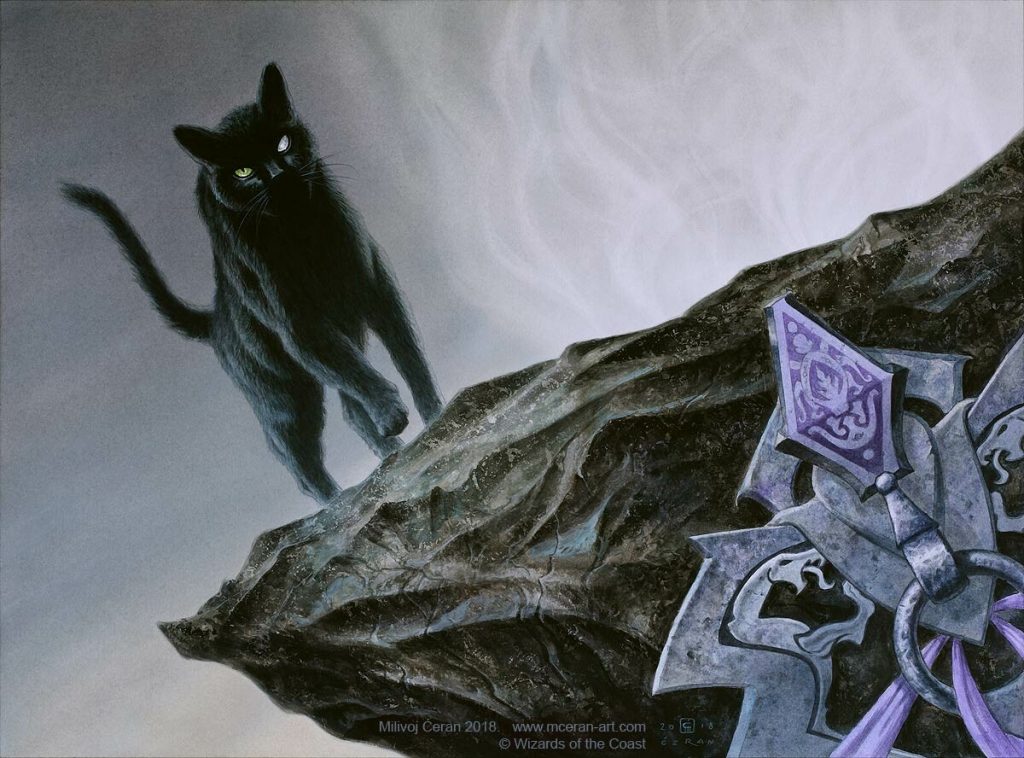
Cauldron Familiar | Illustration by Milivoj Ceran
Winning with an aristocrat deck is often just an inevitable event. The way I see most of these decks win is either very slowly with several individual bits of chip damage thanks to Blood Artist or Mayhem Devil triggers or one huge hit with a big Carrion Feeder or Nantuko Husk.
In theory, every time you sacrifice a creature and get some value out of it, you’ll be accruing a slight edge over your opponent, whether that’s in the form of extra permanents, a small amount of life gain or life loss or even extra cards. If you play well and stave off the threats that your opponents throw at you, these gradual gains will eventually overwhelm your opponent and lead to a victory.
Since you won’t be sacrificing every creature on your board until you have to, you’ll generally need to pay attention to how close you are to winning the game and figuring out when to go all in on an aristocrat. Similarly, if you’re removing your opponent’s creatures then there will be a point at which you will be able to push for an alpha strike with all of the small creatures you’ve put together.
Winning with aristocrats can be very difficult. It’s generally a deck that requires a lot of concentration to play well, but it’s very rewarding when you know what you’re doing with it.
Wrap Up

Blood Artist | Illustration by Johannes Voss
Aristocrats are one of my favorite decks of recent years and something I played a lot of while we were locked down in 2020. Having access to only MTG Arena to play Magic on meant that this was a very easy go-to and will also be my next Commander project.
Are you building an aristocrat deck of your own? Let me know in the comments or over on Draftsim's Twitter. I’d love to see your builds.
Until next time, stay safe and have fun!
Follow Draftsim for awesome articles and set updates:
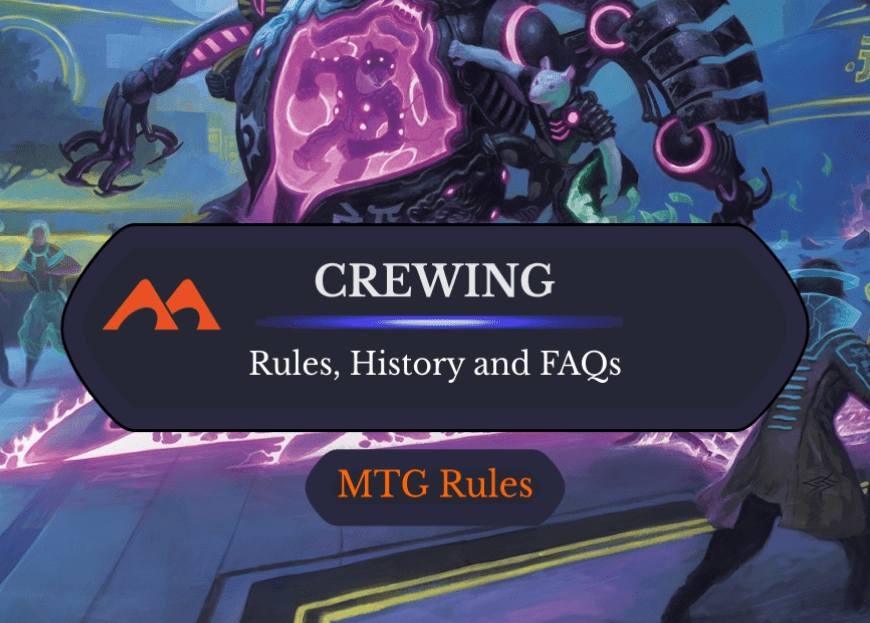
Add Comment